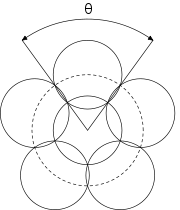Disk covering problem
The disk covering problem asks for the smallest real number such that disks of radius can be arranged in such a way as to cover the unit disk. Dually, for a given radius ε, one wishes to find the smallest integer n such that n disks of radius ε can cover the unit disk.[1]
The best solutions known to date are as follows:
| n | r(n) | Symmetry |
|---|---|---|
| 1 | 1 | All |
| 2 | 1 | All (2 stacked disks) |
| 3 | = 0.866025... | 120°, 3 reflections |
| 4 | = 0.707107... | 90°, 4 reflections |
| 5 | 0.609382... OEIS: A133077 | 1 reflection |
| 6 | 0.555905... OEIS: A299695 | 1 reflection |
| 7 | = 0.5 | 60°, 6 reflections |
| 8 | 0.445041... | ~51.4°, 7 reflections |
| 9 | 0.414213... | 45°, 8 reflections |
| 10 | 0.394930... | 36°, 9 reflections |
| 11 | 0.380083... | 1 reflection |
| 12 | 0.361141... | 120°, 3 reflections |
Method
The following picture shows an example of a dashed disk of radius 1 covered by six solid-line disks of radius ~0.6. One of the covering disks is placed central and the remaining five in a symmetrical way around it.

While this is not the best layout for r(6), similar arrangements of six, seven, eight, and nine disks around a central disk all having same radius result in the best layout strategies for r(7), r(8), r(9), and r(10), respectively. The corresponding angles θ are written in the "Symmetry" column in the above table. Pictures showing these arrangements can be found at Friedman, Erich. "circles covering circles". Retrieved 2016-05-04.
References
- Kershner, Richard (1939), "The number of circles covering a set", American Journal of Mathematics, 61: 665–671, doi:10.2307/2371320, MR 0000043.
External links
- Weisstein, Eric W. "Disk Covering Problem". MathWorld.
- Finch, S. R. "Circular Coverage Constants." §2.2 in Mathematical Constants. Cambridge, England: Cambridge University Press, pp. 484–489, 2003.
- Illustrations of circles covering circles